Añadir un favicon a tu blog de WordPress es un paso sencillo pero poderoso para la imagen de marca de tu sitio. Un favicon es una pequeña imagen que se muestra junto al título de tu sitio web en las pestañas del navegador, marcadores, etc.
El problema es que muchos blogueros noveles pasan por alto este detalle o piensan que es demasiado técnico. Por otro lado, la falta de un favicon puede dificultar que tu público identifique tu sitio de un vistazo, lo que puede reducir las visitas de vuelta o el compromiso.
En WPBeginner, una de las razones por las que utilizamos un favicon es para ayudar a nuestros lectores a reconocer rápidamente nuestro sitio entre sus pestañas abiertas y marcadores. Este detalle también ayuda a reforzar nuestra marca y garantizar una presencia en línea más profesional.
Por suerte, añadir un favicon a tu blog de WordPress no tiene por qué ser complicado. En esta guía, veremos métodos sencillos para configurar el icono de tu sitio y hacer que tu blog destaque.
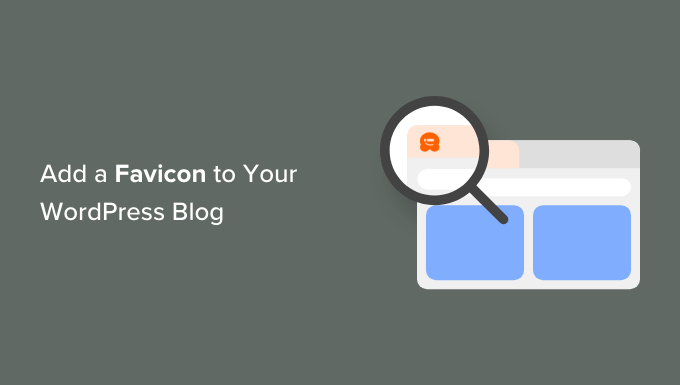
¿Por qué debería añadir un Favicon a su blog de WordPress?
Es esencial añadir un favicon a tu blog de WordPress porque ayuda a los usuarios a identificar rápidamente tu sitio web y refuerza la identidad de tu marca. A partir de ese pequeño icono, los visitantes del sitio pueden reconocer fácilmente tu blog.
Este es el aspecto de un favicon en un navegador / explorador web:

Otro propósito de un favicon de WordPress es mejorar la experiencia del usuario. Cuando hay varias pestañas abiertas, los usuarios pueden mirar los favicons para saber en qué sitio web están y cambiar al que deseen.
Si los usuarios añaden un icono de atajo o marcador a tu blog en sus dispositivos móviles, el favicon aparecerá como icono de aplicación en su pantalla de inicio. Así podrán acceder fácilmente a tu sitio web con un simple toque.
Los favicons también pueden ayudar con la optimización de motores de búsqueda (SEO) de WordPress. Si te fijas en las páginas que aparecen en los resultados de búsqueda, suelen mostrar el favicon del sitio antes del meta título de la página. Esto puede hacer que su sitio web parezca legítimo y digno de confianza.
Cómo crear un Favicon para tu blog WordPress
En primer lugar, vamos a aprender a crear un buen favicon para tu blog.
El tamaño ideal del favicon de WordPress es una imagen cuadrada de hasta 512 píxeles de ancho y alto. El formato de imagen del favicon puede ser ICO, JPEG, PNG o GIF.
SVG también es un formato común para los favicons, pero WordPress no los acepta por defecto. Dicho esto, puedes configurar WordPress para que te permita añadir archivos SVG.
Si tienes un blog de empresa, puedes utilizar el logotipo de tu marca como icono favicon. Si aún no tienes uno, puedes consultar nuestra guía para principiantes sobre cómo crear un logotipo para tu sitio web.
Si tienes un logotipo listo pero quieres que el fondo sea transparente, puedes utilizar Photoshop o una herramienta gratuita de edición de imágenes con un eliminador automático de fondo. Solo tienes que asegurarte de que el formato de archivo es PNG para mantener la transparencia en el favicon.
Otra opción que puedes utilizar es un generador de favicon gratuito como Favicon.io. Esta herramienta te permite personalizar un favicon desde cero y descargar los archivos en formato PNG e ICO.
Con esto en mente, a continuación te explicamos cómo añadir fácilmente un favicon a tu blog de WordPress. Vamos a cubrir 4 métodos, y puede hacer clic en los enlaces de abajo para saltar al método que desea utilizar:
¿Preparados? Empecemos.
Método 1: Añadir un Favicon usando el Personalizador de WordPress
Este es el método más sencillo para cambiar un favicon en WordPress. Todo lo que necesitas hacer es subir la imagen de tu favicon al Personalizador de WordPress, y el resto se hará por ti.
El primer paso es acceder al Personalizador de WordPress. Si utilizas un tema clásico, puedes ir a Apariencia ” Personalizar .
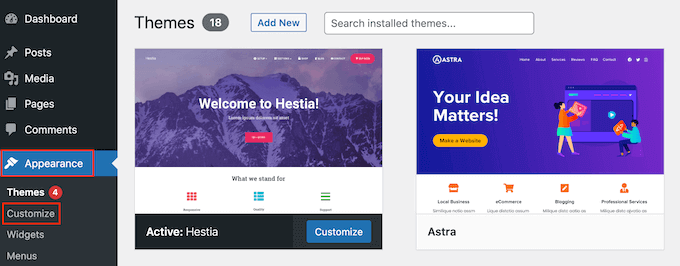
Si está utilizando un tema de bloque y no puede encontrar el Personalizador, a continuación, echa un vistazo a nuestra guía práctica sobre cómo comprobar la falta de Personalizador de temas en el administrador de WordPress.
A continuación, hagamos clic en la pestaña “Identidad del sitio” de la barra lateral izquierda.
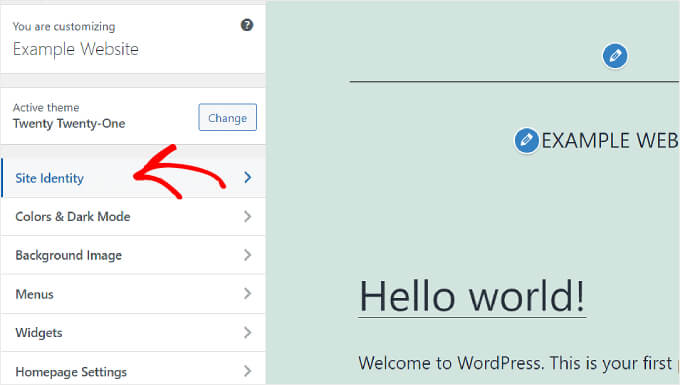
Aquí verá opciones para personalizar el “Logotipo del sitio”, el “Título del sitio”, el “Lema” y el “Icono del sitio”.
Si quieres añadir el favicon de un sitio, tendrás que desplazarte hasta la sección “Icono del sitio” y hacer clic en “Seleccionar icono del sitio”.
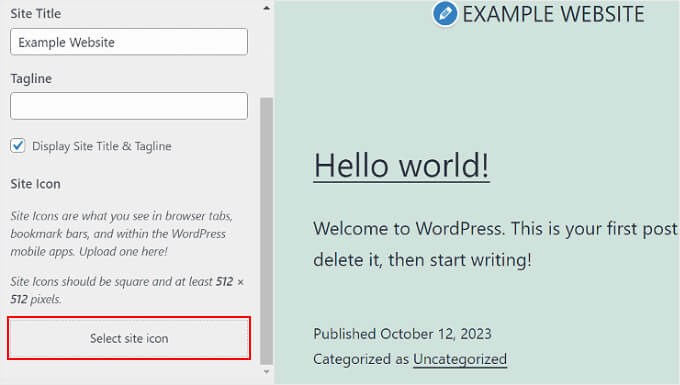
Ahora aparecerá la biblioteca de medios de WordPress. Puede seleccionar una imagen existente o subir un nuevo favicon personalizado desde su ordenador.
En este ejemplo, utilizaremos el logotipo de WPBeginner como icono del sitio de WordPress.
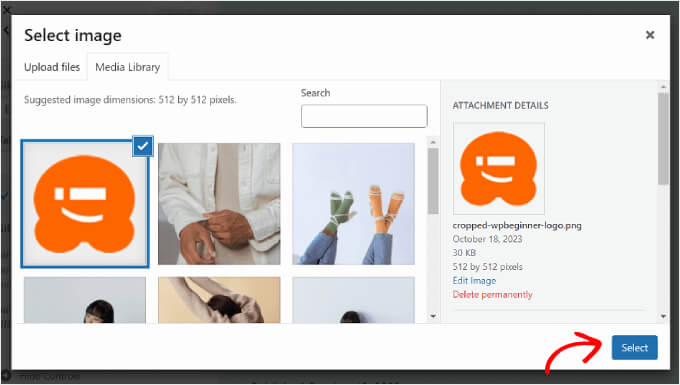
Después de elegir una imagen, haz clic en el botón “Seleccionar” de la esquina inferior derecha de la ventana.
Si el favicon es más grande que el tamaño recomendado, WordPress te permitirá recortarlo. Si coincide exactamente con el tamaño recomendado, puedes dejarlo como está.
Cuando la imagen tenga buen aspecto, haz clic en “Recortar imagen”.
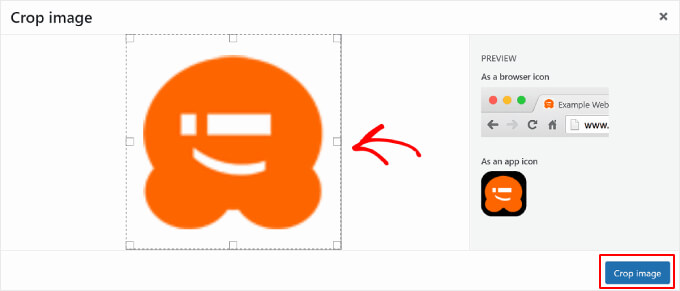
Después de esto, volverás al Personalizador de WordPress. Aquí, usted puede terminar su configuración favicon haciendo clic en el botón ‘Publicar’ en la barra lateral izquierda.
Ya está. Ahora que ha cargado su favicon, puede visitar su sitio web de WordPress para ver si la imagen ya está activa.
Método 2: Añadir un Favicon Usando el Editor de Sitio Completo de WordPress
Si utiliza un tema de bloques y desea añadir el logotipo de su marca como parte de la cabecera de su sitio web y como icono del sitio, este método es para usted.
Para ello, debe ir a Apariencia ” Editor desde el panel de administrador de WordPress.
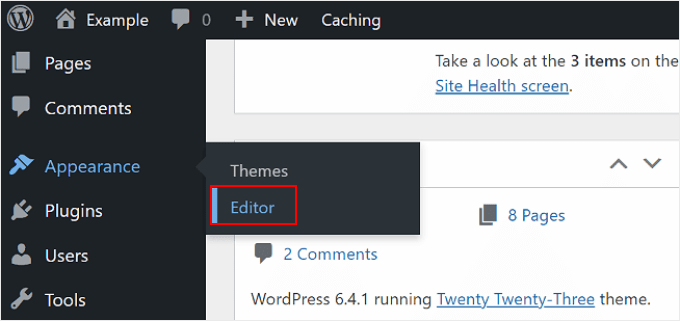
En esta página encontrará varios menús para personalizar su sitio web, como “Navegación” y “Estilos”.
Para este tutorial, tendrá que hacer clic en “Patrones” para acceder al patrón del bloque de cabecera de su sitio web.
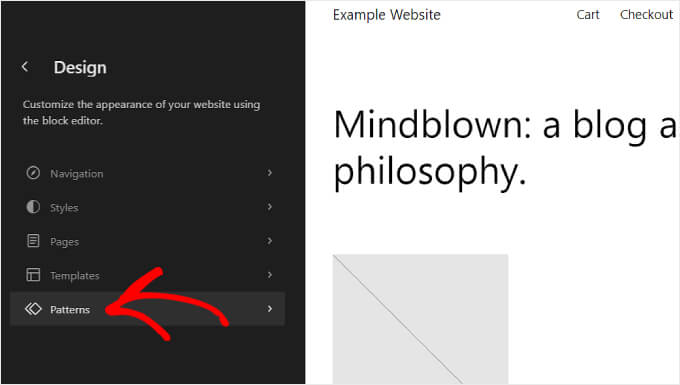
Al desplazarse hacia abajo, verá varias partes de la plantilla:“Encabezado“, “Pie de página” y “General”.
Sólo tienes que hacer clic en la plantilla “Cabecera” para añadir allí tu favicon.
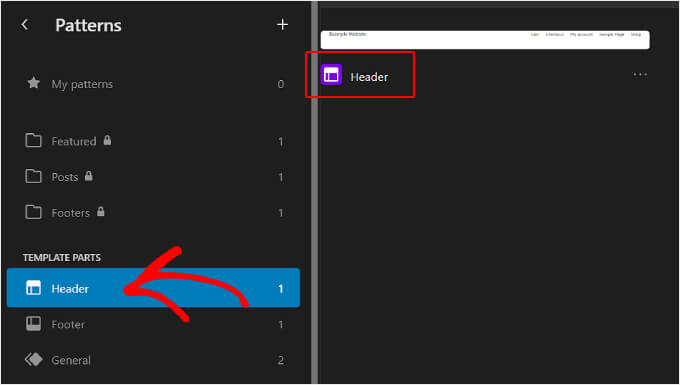
A continuación, verá un botón con forma de lápiz junto al texto de la cabecera.
Sigue adelante y haz clic en él para poder editar el patrón e insertar tu favicon de WordPress.
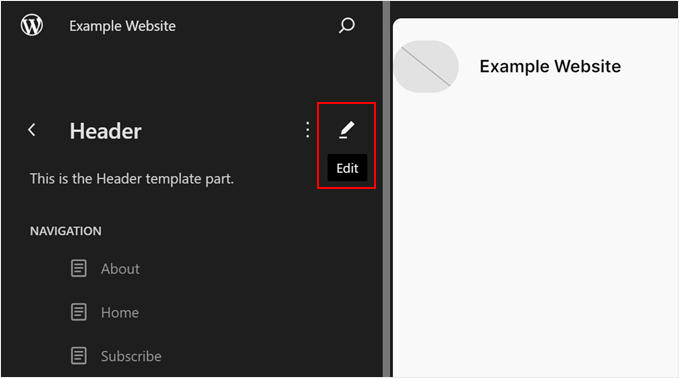
Ahora está dentro de la experiencia de edición completa de WordPress.
Desde aquí, puedes hacer clic en el botón ‘+’ de añadir bloque y buscar el bloque ‘Logotipo del sitio’. Aquí es donde añadirás la imagen que se convertirá en tu favicon de WordPress.
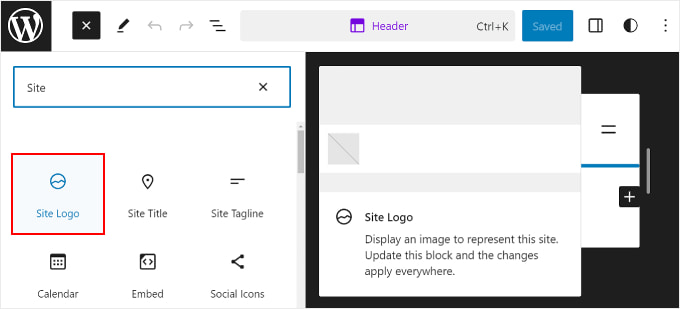
Arrastra y suelta el bloque donde quieras en tu cabecera. En este ejemplo, lo hemos colocado junto al título del sitio web.
A continuación, haga clic en el icono de carga del bloque “Logotipo del sitio”.
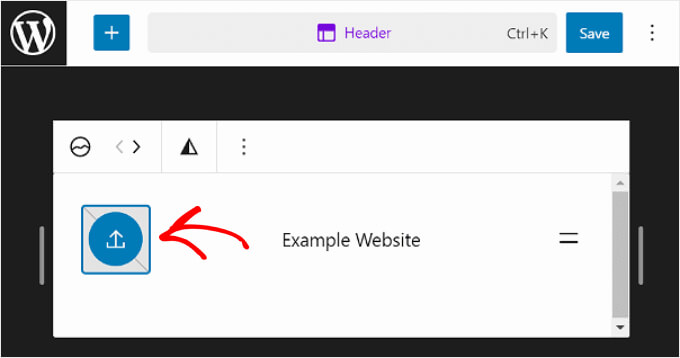
Al igual que con el método anterior, puede elegir una imagen existente o subir una nueva desde la biblioteca de medios de WordPress.
A continuación, ve a la barra lateral de ajustes del bloque, en la parte derecha de la página. Activa la opción “Usar como icono del sitio” para añadir el logotipo como favicon.
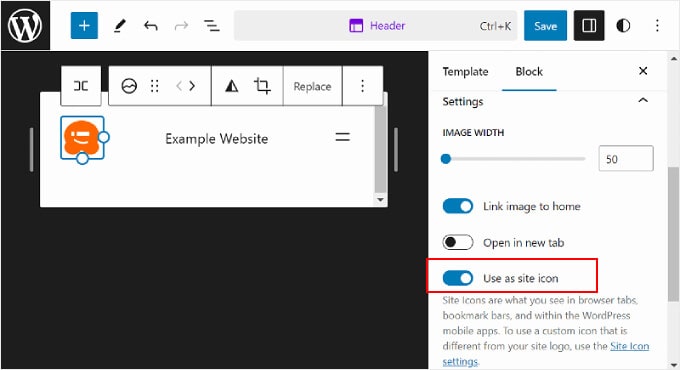
Por último, puedes pulsar el botón “Guardar” en la esquina superior derecha de la página para publicar tu favicon.
Verás un aviso de que el cambio afectará a todo el sitio web. Asegúrate de que la casilla “Icono” está marcada y vuelve a hacer clic en “Guardar”.
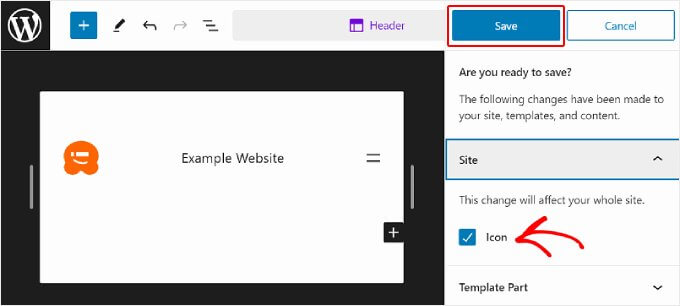
Ahora que ha seguido todos los pasos, puede abrir su sitio web para confirmar que el cambio se ha realizado correctamente.
Método 3: Añadir un Favicon utilizando un plugin de WordPress Favicon
Si prefieres usar un plugin de favicon para WordPress, entonces puedes seguir este método para usar el plugin gratuito Favicon by RealFaviconGenerator.
En primer lugar, debe instalar y activar el plugin. Para más detalles, puedes seguir nuestra guía sobre cómo instalar un plugin de WordPress.
Una vez activado, puede dirigirse a Apariencia ” Favicon en su escritorio de WordPress.
A continuación, sólo tiene que hacer clic en el botón “Seleccionar de la biblioteca multimedia” para cargar una nueva imagen o utilizar una ya existente.
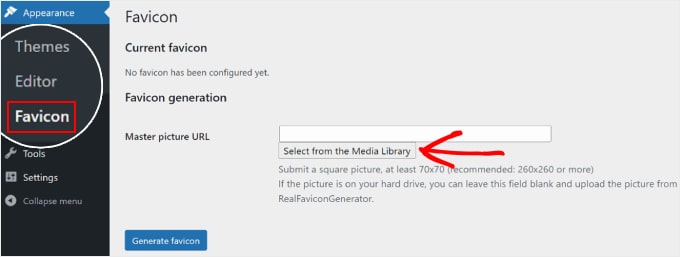
Tenga en cuenta que deberá utilizar una imagen cuadrada. El plugin recomienda que el tamaño del icono del sitio sea de al menos 260 píxeles tanto de ancho como de alto, pero no inferior a 70 píxeles.
Una vez elegida la imagen, pulsa el botón “Generar favicon”.
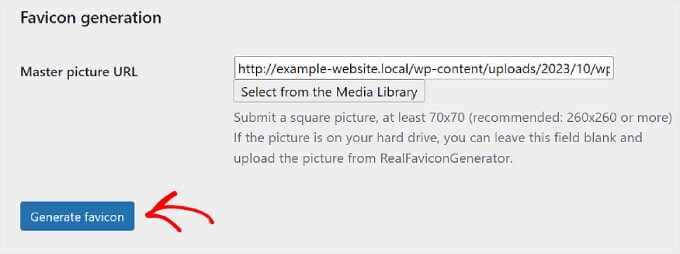
Después de esto, el plugin te llevará al sitio web de RealFaviconGenerator para editar el favicon.
Puedes personalizar varios ajustes, como el color de fondo y su aspecto en las páginas de resultados de búsqueda de Google (SERPs), iOS, Android, macOS Safari, Chrome y Windows Metro.
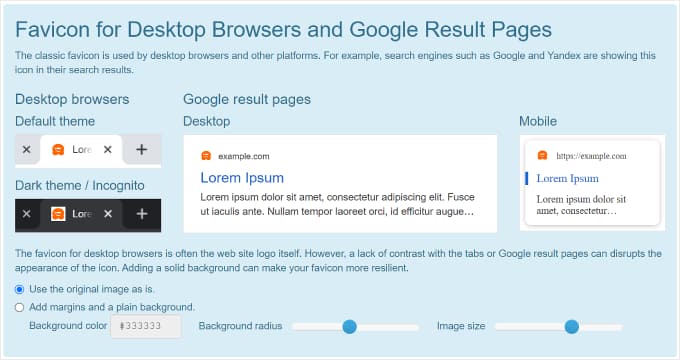
En la sección “Opciones del generador de favicon”, puedes marcar la casilla para comprobar si tu sitio web ya ha utilizado un favicon anteriormente. En caso afirmativo, simplemente introduce un número en el segundo campo para indicar la versión del favicon que estás utilizando.
De este modo, los usuarios que hayan visitado tu sitio antes verán el nuevo favicon en lugar del antiguo.
Una vez que todo se ve bien, todo lo que necesita hacer es hacer clic en el botón “Generar sus Favicons y código HTML” para añadir el favicon a su sitio de WordPress.
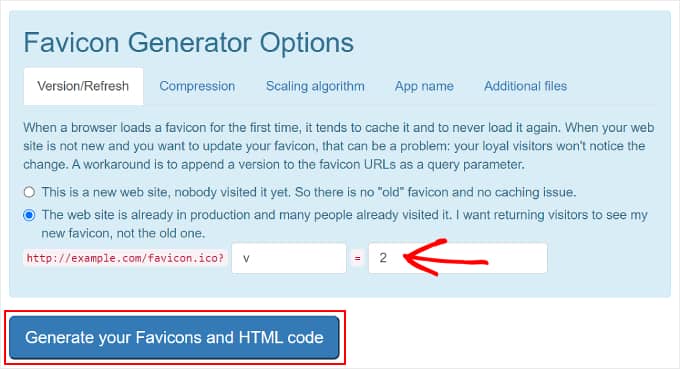
Tu favicon ya debería estar activo. Asegúrate de mantener activado el plugin favicon de WordPress para que el favicon esté siempre activado / activo.
Método 4: Añadir un Favicon manualmente a su blog WordPress
Por último, pero no menos importante, puedes añadir un favicon de WordPress a tu blog editando manualmente los archivos de código de tu tema.
Esto es útil si su personalizador de temas no tiene la sección “Identidad del sitio” o si utiliza un tema de bloque y desea una imagen de favicon diferente del logotipo de su sitio.
La forma más fácil y segura de editar los archivos de código de tu tema es con el plugin WPCode.
WPCode es el mejor plugin de fragmentos de código para principiantes. Con más de 1700 fragmentos listos para usar y una gestión de errores segura, te permite insertar código personalizado de forma segura sin romper tu sitio web.

Otra gran cosa acerca de WPCode es que si actualizas tu tema, entonces no perderás tus modificaciones de código, incluyendo tu favicon.
Para esta guía, puedes utilizar la versión gratuita de WPCode. Sin embargo, con la suscripción Pro, tendrás acceso a características como la lógica condicional inteligente y las integraciones de terceros para gestionar tu código de forma más eficiente.
Para empezar, necesitas instalar y activar WPCode. Para más información, puedes consultar nuestra guía paso a paso sobre cómo instalar un plugin de WordPress.
Lo siguiente que tienes que hacer es preparar tus archivos de favicon. Para ello, puedes utilizar un generador de favicon gratuito como Favicon.io.
En el sitio web, puedes hacer clic en “Imagen” para convertir un archivo de imagen en un archivo zip y un código HTML. También puedes utilizar las opciones “Emoji” o “Texto” para crear un favicon con los emojis y fuentes disponibles.
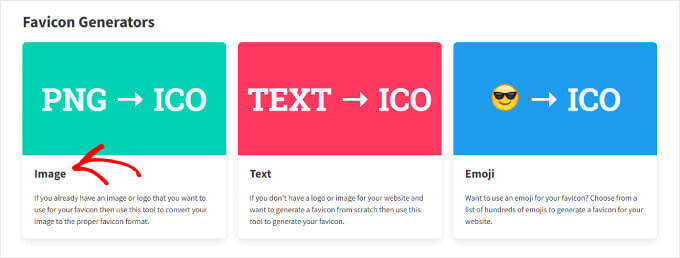
En la página siguiente, puedes subir tu imagen. A continuación, haz clic en “Descargar” para guardar el archivo zip del favicon, que contiene los archivos favicon.png y favicon.ico.
Asegúrese de mantener esta página web abierta mientras realiza los pasos siguientes.
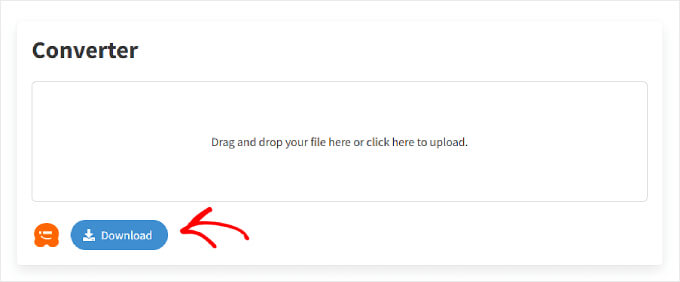
Ahora, tienes que subir el archivo zip del favicon al directorio raíz de tu sitio. Para ello, puedes utilizar el gestor de archivos de tu alojamiento WordPress.
Alternativamente, puede hacerlo a través de un cliente FTP como FileZilla. Para más detalles, compruebe nuestra guía para principiantes sobre cómo usar FTP para subir archivos a WordPress.
Una vez que haya abierto los archivos de su sitio web a través del gestor de archivos o FTP, navegue hasta el directorio raíz.
El directorio raíz de WordPress suele ser una carpeta llamada ‘public’ o ‘public_html’, y contiene carpetas esenciales de WordPress como wp-content y wp-admin.
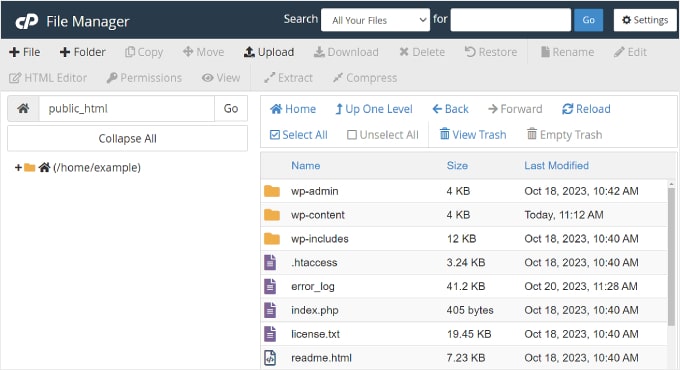
En este punto, puedes extraer y subir todo el contenido del archivo favicon que descargaste previamente al directorio raíz.
Si utiliza el Gestor de Archivos, puede hacer clic en el botón “Subida” situado cerca de la parte superior.

A continuación, aparecerá una nueva pestaña en la que se le pedirá que suba los archivos.
En esta página, puedes hacer clic en el botón “Seleccionar archivo” y elegir todos los archivos de favicon.
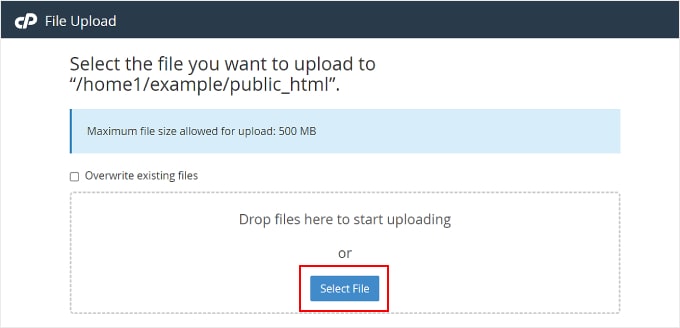
Ahora, sólo tiene que esperar a que los archivos se suban correctamente.
Una vez hecho esto, puedes volver a la pestaña de gestión de archivos. Ahora deberías ver todos tus archivos favicon en el directorio raíz, como en la siguiente captura de pantalla:
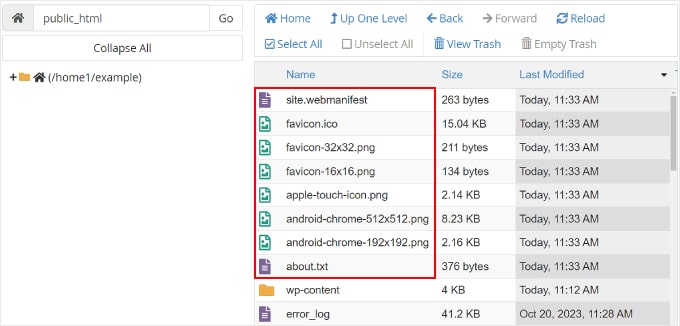
Ahora, volvamos al panel de administrador de WordPress.
En la barra lateral izquierda, navegue hasta Fragmentos de código ” Encabezado y pie de página.
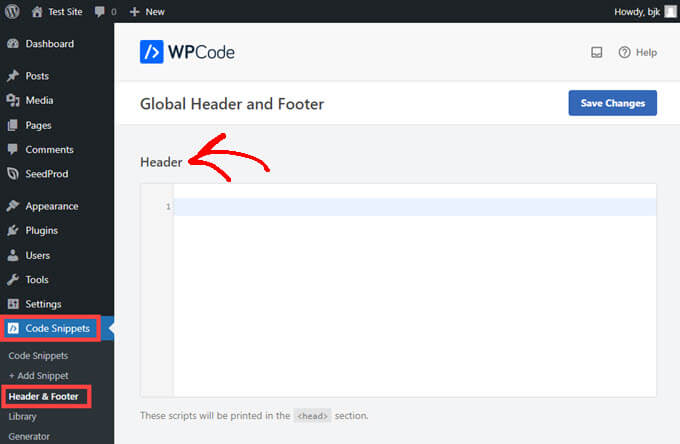
Después, vuelve a la pestaña Favicon.io de antes.
A continuación, copie el código HTML. Debe tener 4 etiquetas link rel en el código.
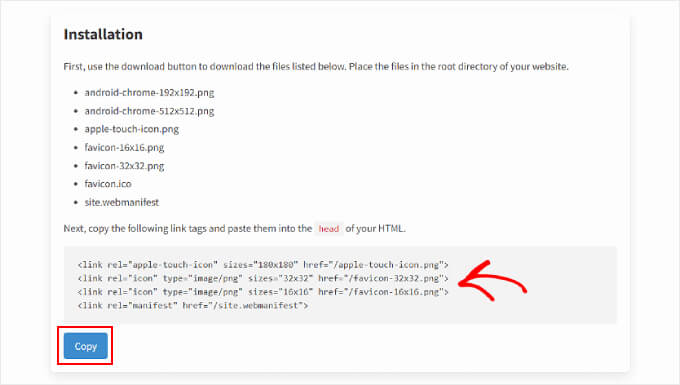
A continuación, tienes que volver a WordPress y pegar el código en la sección “Encabezado” de la página WPCode. Esto añadirá el código al archivo header.php de tu sitio web.
En el código, inserte la URL completa de su sitio web entre comillas junto a todos los atributos href, como en el ejemplo siguiente. Recuerde añadir http:// o https:// si su sitio utiliza un certificado SSL.
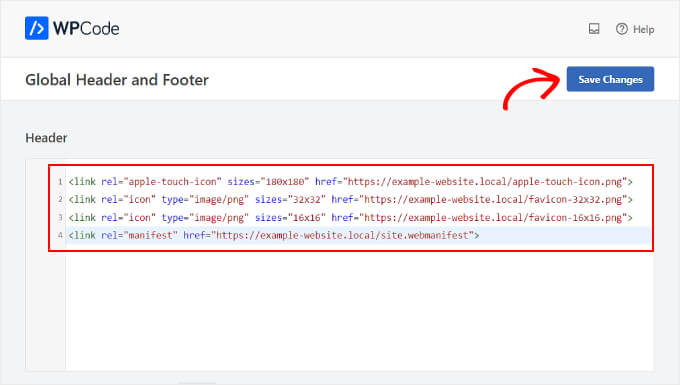
Por último, puede hacer clic en el botón “Guardar cambios” de la esquina superior derecha.
Y ya está. No olvides visitar tu sitio web para comprobar si el cambio de favicon ha sido correcto.
¿Por qué no se muestra mi Favicon de WordPress?
Una de las razones por las que tu favicon de WordPress puede no mostrarse es debido a la caché del navegador / explorador. Esto significa que su navegador sigue mostrando la versión antigua de su sitio.
Para solucionar este problema, tienes que borrar la caché de tu navegador. Si necesitas ayuda, puedes seguir nuestra guía sobre cómo borrar la caché del navegador.
También es posible que esté utilizando un servicio CDN que aún almacene la versión antigua de su sitio. En ese caso, tienes que purgar la caché de la CDN para actualizar el contenido de tu sitio web.
Para comprobar si el icono de su sitio WordPress se ha cargado, puede abrir su sitio web en modo incógnito o en una ventana de navegación privada.
Si la instalación del favicon no ha tenido éxito, puedes intentar volver a subir la imagen con un nombre de archivo diferente para resolver el problema / conflicto / incidencia.
Es posible que la característica de icono de tu sitio de WordPress tampoco funcione debido a un error de contenido mixto. Para solucionar este problema, comprueba nuestra guía sobre cómo corregir los errores de contenido mixto de WordPress.
En algunos casos, también puede descubrir que su sitio web muestra el favicon de su proveedor de alojamiento en lugar del suyo propio. Si esto ocurre, ponte en contacto con su equipo de soporte para resolver el problema.
Recomendamos elegir un servicio de alojamiento de WordPress de confianza con un excelente servicio de soporte al cliente para tratar problemas como este de forma eficaz. Puede marcar / comprobar nuestra lista de los mejores proveedores de alojamiento WordPress para encontrar la mejor opción para su sitio web.
Por último, es posible que desee comprobar si su tema de WordPress tiene una herramienta específica para subir un favicon. Esto puede explicar por qué los métodos anteriores no te funcionan.
Esperamos que este artículo te haya ayudado a añadir un favicon a tu sitio de WordPress. También puedes consultar nuestra selección de los mejores creadores de logotipos gratuitos para que parezcas un profesional y nuestra guía sobre cómo añadir fácilmente fuentes de iconos a tu tema de WordPress.
If you liked this article, then please subscribe to our YouTube Channel for WordPress video tutorials. You can also find us on Twitter and Facebook.




mohadese esmaeeli
In my opinion, having a favicon can attract the audience’s attention and add a stylish and aesthetic touch to the website in the browser. Perhaps it can capture the viewer’s gaze and be a distinctive feature.
mohadese esmaeeli
Hello. The favicon section of my website is not working. Even when I provide the url in the theme settings, it doesn’t show. I also tried from the site ID part, but it gives an error of not processing the image. Can you please guide me on this?
WPBeginner Support
If you are using the built-in option for your theme then we would first recommend reaching out to your theme’s support as they may have a specific requirement for the favicon image using their tool.
Admin
Jiří Vaněk
The last time I uploaded a favicon to a website, I struggled for a really long time with the icon not showing up on the website. I cleared the browser cache and wordpress itself and it didn’t help. She didn’t show up on her own until a few hours later. If someone is having trouble with it, the cache can be in many places. CDN, on the network element at home, on the server. So sometimes it’s good to just wait a while and not stress right away. Otherwise, the Favicon is a small thing, but it is a great way to customize your own page.
WPBeginner Support
Having a favicon can help with your SEO as well as to help users remember your site but it is not required and the first favicon you set can be changed to a different one later on.
Admin
Peter Iriogbe
Now I see why site owners stick to using Favicon which looks the same as their site logo.
Peter Iriogbe
Is it a must to upload a favicon or does it influence ranking on search?
Jiří Vaněk
Favicon is not necessary and does not affect SEO and search in any way. It is the personalization of the page. A favicon is great in two ways. If someone adds your page to their favorites, they will immediately recognize it by the favicon and do not have to search for a long time. The second great thing is when you have multiple pages open in your browser. You can also recognize the given page immediately by the favicon. So I definitely recommend having it, even if it doesn’t really affect SEO and search itself.
mohadese esmaeeli
Exactly, I agree. I’ve experienced the same issue. Often, when searching, I open various websites, and after an hour, I realize I have many tabs open in the Chrome browser, right in front of my eyes! However, having a favicon helps me quickly locate my desired site among the numerous tabs.
Javi
second alternative worked, thanks
WPBeginner Support
Glad to hear it worked
Admin
Meer Hamza
Is it manadatory to upload favicon at wordpress website in ICO file format.
WPBeginner Support
No, it does not need to be an ico format.
Admin
Meer Hamza
1-Is it ok to just upload site Icon from theme>customize>site Icon. Will it show as favicon?
2-I upload site Icon on wordpress website. Is it necessary to show Favicon at URL website.com/favicon
WPBeginner Support
1. Yes it is fine to upload it from there
2. It is not necessary but it can be helpful for finding the favicon later.
Admin
Alex Perry
Thanks, after 2 hours of searching I finally found it. How to change the site icon…
WPBeginner Support
Glad our guide allowed you to add it instead of needing to search further
Admin
Ben
I think this needs an update. I tried this and there’s no “Site Identity” tab under Appearance > Customize
WPBeginner Support
Your specific theme may have a custom editor or if you are using the block editor you could add the site logo block, set an image, and in the block’s settings have that set as the site’s favicon.
Admin
FAIZ
what a great guide, really it’s very helpful
WPBeginner Support
Happy to hear our guide was helpful
Admin
Max Anderson
What does the WPBeginner favicon represent?
WPBeginner Support
Our blob is a simple design of a face smiling using an exclamation point and parenthesis
Admin
AL
Hi, what to do when Favicon is not showing on chromium-based browser and shows up in Firefox.
WPBeginner Support
You would normally want to clear your site’s cache as well as try setting the favicon again for a common reason.
Admin
John
I’m new to this so would appreciate some guidance with favicon. The website I’m trying to look after needs the favicon changing. Can I load a new image as a favicon that will overwrite the favicon currently on the pages or must i delete the current one then load a new image?
Thanks for any reply
WPBeginner Support
You would want to reach out to the support for your specific theme for if your theme has this option.
Admin
Ray
I was fine on the video until you said “click on site identity”… there is no such tab on my version. The first option is “Global” then Header, Breadcrumb, UberMenu{main], Blog, etc. No “Site Identity”…so obviously without being to get to that screen I’m not going anywhere. Is there another way in?
WPBeginner Support
If your theme has different settings and you are unable to find the favicon in the customization settings, you would want to reach out to the support for your specific theme to see if they have it located in a theme-specific area.
Admin
Krishna
Hii Wpbeginner!
I’m using Astra theme my website Favicon is working every one except Google search results. How can I fixed it?
WPBeginner Support
You would need to wait for Google at the moment.
Admin
Soul sultan
This is the awesome guide about how to add favicon on wodpress blog
WPBeginner Support
Thank you, glad you found our content helpful
Admin
Shomirul Islam Bonny
Thanks! It helped me!
WPBeginner Support
You’re welcome, glad it helped
Admin
Munendra Singh
all helpful post,, thanks
WPBeginner Support
Glad you found our post helpful
Admin
Raj
Great ! I always go through from your tutorials when ever i get stuck in any kind of issue. Thanks for it.
WPBeginner Support
Thanks, glad our articles could help
Admin
John Barson
Can’t Add a Favicon to Your WordPress Website? That was my problem. I did a fair bit of research where I finally found my issue. It was because the PHP GD Library was not enabled. Fortunately, I control my own server. I had upgraded the server PHP to v7.2 but I forgot to enable the PHP GD library. So…if you find when you try to add the site icon in the appearances section of your wordpress admin and the image you upload/select is not being accepted or you can’t use the crop image feature it is most likely because your webserver host has not enabled the GD Library.
WPBeginner Support
Thanks for sharing this information should someone else run into that issue
Admin
Cean Herzfield
Thank you so much! You saved me a lot of frustration because I’m working on Xampp and it was disabled by default. Now wouldn’t it have been nice if they had mentioned it in the article.
Pritam
Favicon of my website was visible before I changed DNS for Cloudflare. Now it is visible in the admin side but not on the website. How to solve this problem. you can check on my website
Michele A
This tutorial was wonderful! Thank you so much for the great work!
Jacques
My Favicon is updating in ADMIN side, but not on user side
Tracy
Were you able to figure out how to fix it?
RAJ
“When I go to the “Site Identity” tab, there is no place to upload a site icon. The only option I have is the “Site Title”. That’s ALL!
I am using WordPress 4.7.3.”
Bekzat Sadykov
I guess, the WP theme you are using doesn’t have favicon implemented. So, if it is not declared in theme functions.php file, it won’t appear in admin/editor side.
You can hardcode it to header.php or use third-part plugins.
jacob
scroll down a little you will see the place to upload your favicon
Eleanor
Hi, I recently updated my website from HTTP to HTTPS and when that happened, the site icon stopped working. Does this mean that somewhere along the line I’ve missed a step? I’ve tried changing the image and reuploading a new one and that hasn’t worked. If someone types in the website URL using http then the old favicon (and not site icon) shows up, but the minute it’s https, then it disappears. The site icon though is visible when I’m logged into the dashboard.
Matt Parker
Eleanor
I’m on HTTPS and I have the same issue, did you find a solution?
Favicon only shows when I’m logged in in admin mode!
Jimmy
When I go to the “Site Identity” tab, there is no place to upload a site icon. The only option I have is the “Site Title”. That’s ALL!
I am using WordPress 4.7.3.
Please help!
Ahmed Akeem
I guess, the WP theme you are using doesn’t have favicon implemented. So, if it is not declared in theme functions.php file, it won’t appear in admin/editor side.
You can hardcode it to header.php or use third-part plugins.
Abubakar Sahabi Rafi
It really helped, more grease to our elbow.
Tim
Can anyone tell me how this new “Site Icon” feature is supposed to work? I get to the point where the file is uploaded and I get a dialog box that offers to crop the image. The problem is 1) my image doesn’t need to be cropped and 2) there’s no “Save” button (or “Done” or anything similar), only a “Crop” button and the upper right corner X to close the dialog. If I click “Crop” I get an error (Error cropping this image, bla bla bla) and if I hit the X it closes. Either way, my image is not saved as a Site Icon (even though it is saved in the media library. After deleting the image, resizing it to exactly 512×512, I upload it again. This time, no crop dialog, just the “Select” image dialog. I click select, the image has a box around it and a check mark and nothing else happens. No Save, etc. When I close the dialog, there’s still “No image selected.” This happens in Chrome AND Firefox. I’m ready to throw WordPress away and hand code everything. I haven’t used WordPress in a couple of years and I’m frustrated with what seems like buggy, poor design and feature bloat.
Brian
code easy to interpret, it worked out. thanks…
Jason
Why does it need to be 512 pixels for an icon? I’m hoping it’s converted somewhere inside WordPress, once and done, and not on every load. 512×512 is crazy for something that would very rarely be bigger than 32X32, unless I am missing something?
John Krawczyk
Article not useful. Everyone tells you to make a path to your favicon & that’s it.
However do you include http: www http do you specify .ico .png?
Nobody says anything in detail.
WPBeginner Support
Hi John,
Yes you need to include full URL like this:
https://www.wpbeginner.com/favicon.pngAdmin
Joe
Using WP4.7 and the Site Icon functionality works, but it just seems off to me. The result is 4 links in the section:
But it creates 10 different versions of the site icon image in addition to the original at sizes of 32×32, 100×100, 150×150, 180×180, 192×192, 250×250, 270×270, 300×300, 360×360, 500×310.
Why so many cropped images if only 4 linked to?
Also, I submit an icon image sized 512×512 as recommended, but the 500×310 version is always cropped so the top and bottom of the icon is cut off. Is there any way around this and/or is it a big deal?
What browser support does this WP Site Icon cover (mostly in respect to how far back in IE)?
Thanks!
Marieke
In Whatsapp, the image which appears left to a link address if you send a link: is that the same icon? Because I don’t see it there.
Sunil
Marieke, It’s featured image, you upload to a particular post.
Cos
The ICO Format plugin for Adobe Photoshop does not allow images more than 256 pixels high or wide. So how do you create one that’s 512px???
Marieke
It doesn’t need to be made an .ico. Just a plain .png or .lpg will do when you work in WordPress.
Salim Ahmed
Informative instruction. Now i following your tips and tricks. Thanks for sharing it.
Taimoor Ahmed
Kindly tell me any website or a software from where I can make an effective favicon for my site in a quick time????
Kirstie
Thank you for another simple to follow tutorial. I’m a true beginner and y’all do a great job explaining things in a way I can understand.
WPBeginner Support
Thanks, glad you find our tutorials helpful.
Admin
Nelson
thanks good tut easy and works
c
the add logo in some themes isn’t for favicon its for the header logo
ccstacyline
how come my side identity menu doesn’t have the service for site icon? I am so frustrated… can you help ?
John Davis Frain
Are the instructions you give here theme-specific? I’m using the Delicacy theme, and it doesn’t give me that option to alter Site Identity and insert a Favicon.
WPBeginner Support
No it is not theme specific. Make sure you are using the latest version of your theme.
Admin
Mad Dog Malcs
Hi There, I also don’t see the site identity tab, I am using the sketch theme, how do I update a theme?
Thanks in advance, Malcs
shashi
i may go to theme custimztion..there u see the option of uploading the favicon icon easliy…
Antonios
You might not see the word “favicon” probably site icon. If you see a scrow bar you might have to scrow all the way down to see the select image box.
a
You can add favicon by WordPress’ “Costumize” editor, which can be found in every wordpress site.
Alan
I upload a PNG file that is exactly 512×512 pixels, WordPress saves it, and then I end up with a cropped image in my media library. Super annoying! WordPress 4.4.
Alan
I should add that the new, cropped image is exactly the same dimensions as the original I uploaded, but now I have two in my library (albeit one has been processed twice, and has actually increased two kilobytes in file size!).
Katherine Johnston
I have gone through the directory, exactly as you described, but my Site Identity tab only has “Site Title”, “Tagline”, and a checkbox for displaying header text. How can I fix that? Or do I have to go the FTP route?
Thanks for the help!
Rahul Thakur
thank you so much, very simple way love it.
Liz
Excellent instructions, took me about 32 seconds to do it. Fabulous! Thank you
Erin
Thanks! This was very helpful.
Marie Bock
Wow! That was so easy with the newer version of WordPress.
Matt
Super-easy! Thanks for that – I just need to go away and design a better logo now
Viscoun
Doesn’t work. When I got to Customize > Site Identity, the site icon option doesn’t show up – it only says “Site Title” and “Tagline”.
david
what version of wordpress are you using?
Harshpreet
Hi same is the problem I am facing and I am using the website of wordpress on my laptop for building up my blog!
Gina
I’m having the same problem. I’m using wordpress directly online, I haven’t downloaded anything. No “site icon” option at all.
WPBeginner Support
Please see our guide on the difference between self hosted WordPress.org vs free WordPress.com blog.
Admin
Lourika
It took me forever to figure it out!!!!
In the top left corner, click on MY SITES
Go to WP Admin
Then click on SETTINGS
and you will be able to change the icon (picture) on the right hand side……